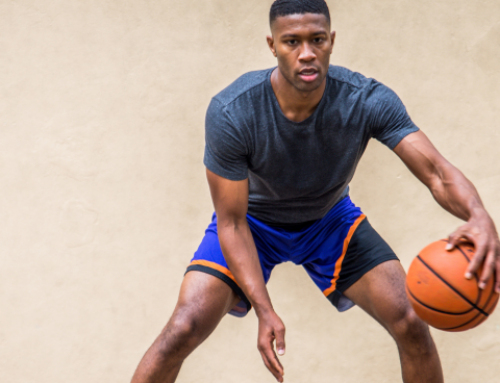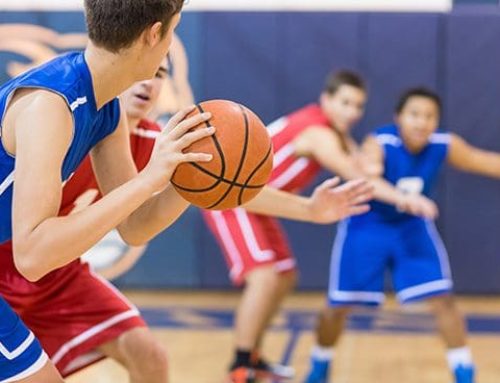How to Train the Three Elements of Basketball Speed
Basketball speed is a coveted trait. Many athletes attempt to develop it inefficiently, because their workouts miss the three major elements of speed: acceleration, deceleration and change of direction.
By incorporating basketball movements into their speed work, players will be able to improve their performance in games. The following drills, great to add at the beginning of practice (after a dynamic warm up), will help tremendously in increasing the speed of your basketball team and players.
Training for Acceleration
Acceleration is the first speed element basketball athletes need to consider when training. In simple terms, it’s the amount of time it takes to start running. An explosive first step makes you more dangerous, both offensively and defensively. My favorite drill for acceleration and first step quickness is the Tennis Ball Drop of my mentor, Alan Stein. (Video above)
- Position player on the baseline in athletic stance (shoulders over knees over toes) facing teammate standing on free throw line holding two tennis balls at shoulder height
- Player on free throw line drops tennis ball on either side
- Player explodes off baseline to catch tennis ball after only one bounce
Training for Deceleration
In my opinion, this is the most important element of speed, and its significance is misunderstood. Deceleration is the ability to slow your momentum so you can quickly change speed or direction. It can make up for a lack of top-end speed on offense, because it allows you to get your defender off balance; and and unbalanced defender is less effective at guarding the ball. My favorite drill for deceleration is the Full-Court Closeout:
- Line players up on the baseline, each in athletic stance
- On your whistle or signal, players begin to sprint down court
- On your second whistle, players break down into closeout stance
- Continue alternating sprinting and breaking down to closeout for a designated time (typically between one and two minutes)
This drill is great for not only deceleration but also for closeout stance and conditioning, providing lots of value in one drill.
Training for Change of Direction
Since it incorporates both acceleration and deceleration, change of direction should be trained last. Change of direction drills are important, because the faster you can change direction, the more likely you are to get by your defender. On the opposite end of the spectrum, the faster you can change direction, the harder it will be to score against you. (See Get Faster: Change of Direction and Agility.) Here is a basic but extremely effective Change of Direction Drill:
- Position player at intersection of one lane line and baseline
- On your signal, player sprints to the elbow
- At the elbow, player begins defensive slide across free throw line
- From opposite elbow, player backpedals to baseline
- Player repeats pattern in opposite direction
- Perform non-stop for 30 seconds
RECOMMENDED FOR YOU
MOST POPULAR
How to Train the Three Elements of Basketball Speed
Basketball speed is a coveted trait. Many athletes attempt to develop it inefficiently, because their workouts miss the three major elements of speed: acceleration, deceleration and change of direction.
By incorporating basketball movements into their speed work, players will be able to improve their performance in games. The following drills, great to add at the beginning of practice (after a dynamic warm up), will help tremendously in increasing the speed of your basketball team and players.
Training for Acceleration
Acceleration is the first speed element basketball athletes need to consider when training. In simple terms, it’s the amount of time it takes to start running. An explosive first step makes you more dangerous, both offensively and defensively. My favorite drill for acceleration and first step quickness is the Tennis Ball Drop of my mentor, Alan Stein. (Video above)
- Position player on the baseline in athletic stance (shoulders over knees over toes) facing teammate standing on free throw line holding two tennis balls at shoulder height
- Player on free throw line drops tennis ball on either side
- Player explodes off baseline to catch tennis ball after only one bounce
Training for Deceleration
In my opinion, this is the most important element of speed, and its significance is misunderstood. Deceleration is the ability to slow your momentum so you can quickly change speed or direction. It can make up for a lack of top-end speed on offense, because it allows you to get your defender off balance; and and unbalanced defender is less effective at guarding the ball. My favorite drill for deceleration is the Full-Court Closeout:
- Line players up on the baseline, each in athletic stance
- On your whistle or signal, players begin to sprint down court
- On your second whistle, players break down into closeout stance
- Continue alternating sprinting and breaking down to closeout for a designated time (typically between one and two minutes)
This drill is great for not only deceleration but also for closeout stance and conditioning, providing lots of value in one drill.
Training for Change of Direction
Since it incorporates both acceleration and deceleration, change of direction should be trained last. Change of direction drills are important, because the faster you can change direction, the more likely you are to get by your defender. On the opposite end of the spectrum, the faster you can change direction, the harder it will be to score against you. (See Get Faster: Change of Direction and Agility.) Here is a basic but extremely effective Change of Direction Drill:
- Position player at intersection of one lane line and baseline
- On your signal, player sprints to the elbow
- At the elbow, player begins defensive slide across free throw line
- From opposite elbow, player backpedals to baseline
- Player repeats pattern in opposite direction
- Perform non-stop for 30 seconds












